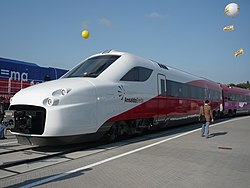 A V250 at Innotrans 2008 in Berlin | |
| Franchise(s) | International joint operation Service began in 2009 |
|---|---|
| Main station(s) | Amsterdam Centraal, Schiphol Airport, Rotterdam Centraal, Breda, Antwerpen-Centraal, Brussel-Centraal Brussel-Zuid/Bruxelles-Midi |
| Fleet size | 19 V250 sets (AnsaldoBreda) NS Hispeed class 186 |
| Stations called at | 10 V250 (expected) |
| Parent company | NS International and NMBS/SNCB |
| Other | |
| Website | www |
Fyra route map | ||||||||||||||||||||||||||||||||||||||||||||||||||||||||||||||||||||||
|---|---|---|---|---|---|---|---|---|---|---|---|---|---|---|---|---|---|---|---|---|---|---|---|---|---|---|---|---|---|---|---|---|---|---|---|---|---|---|---|---|---|---|---|---|---|---|---|---|---|---|---|---|---|---|---|---|---|---|---|---|---|---|---|---|---|---|---|---|---|---|
| ||||||||||||||||||||||||||||||||||||||||||||||||||||||||||||||||||||||
Fyra (Dutch: [ˈfiːraː]) was an international high-speed rail service between the Netherlands and Belgium using the AnsaldoBreda V250 train. The service used the HSL-Zuid and HSL 4 railway lines to connect Amsterdam, Schiphol Airport, Rotterdam, Antwerp and Brussels.[1] Continuous technical difficulties suspended the service, and it was eventually permanently halted due to reliability and safety concerns.
The high-profile project was a collaboration between NS International (a joint venture of NS and KLM) and NMBS/SNCB.
A Dutch domestic service also using HSL-Zuid was branded under the same name. Despite using the tracks built for high speed trains the service between Amsterdam and Breda used conventional trains propelled by a TRAXX locomotive. Its name was changed into Intercity Direct to avoid confusion with the failed international service.
The name "Fyra" represents pride, and is derived from the Dutch word fier and the French word fière, both meaning proud. Fyra is also the Swedish word for four, and is said to represent the four important cities which the new trains were intended to serve — Amsterdam, Rotterdam, Antwerp and Brussels.[2]